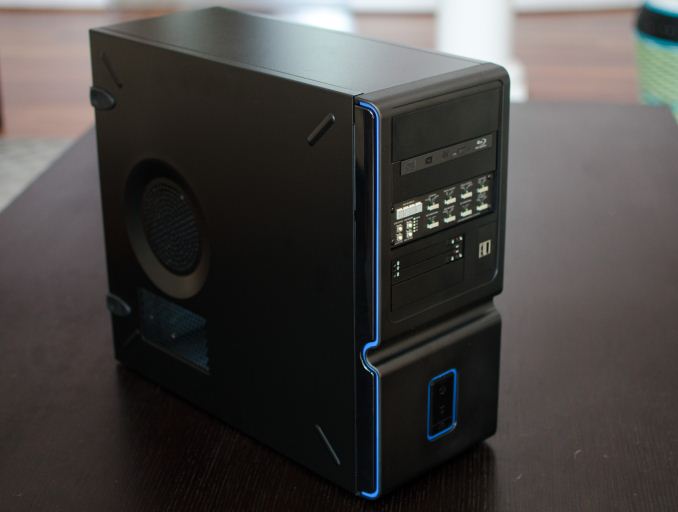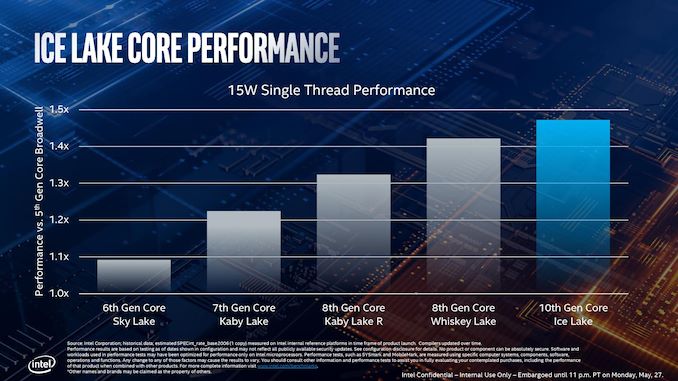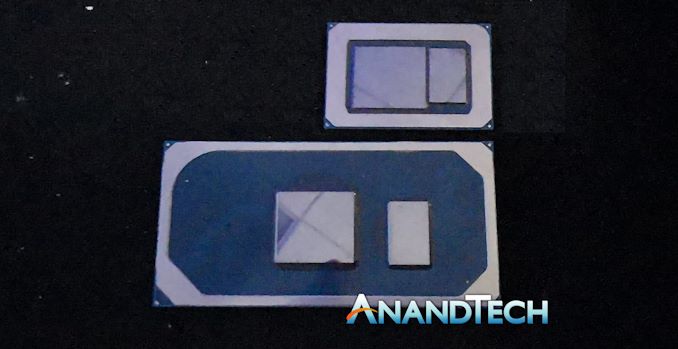The Ice Lake Benchmark Preview: Inside Intel's 10nm
by Dr. Ian Cutress on August 1, 2019 9:00 AM EST- Posted in
- CPUs
- Intel
- GPUs
- 10nm
- Core
- Ice Lake
- Cannon Lake
- Sunny Cove
- 10th Gen Core
Conclusions
First of all, I must say that Intel offering us to test a reference system in advance of a launch is a very good thing indeed. It is not something that Intel has done often in the past – in fact the last time I remember it happening was with Broadwell, when Intel sampled us one of their mobile CRB (consumer reference board) systems for the 45W chip. Before that, Intel had a small attempt allowing the press to benchmark Conroe in 2006 with canned pre-provided benchmarks, which did not go down to well. So moving into this pre-testing regime gets some immediate kudos to those who approved the testing.

Intel’s Broadwell / Crystalwell Mobile CRB
Given that the Ice Lake platform is more geared up towards ultra-premium designs, the software development system we ended up testing was certainly a reasonable expectation and direction that these parts would go in. Of course, we only had the best part of nine hours to test, and giving us the option to test both 15W and 25W modes meant we had to pick and choose what tests we thought were relevant. My most prominent feedback to Intel would be to give us two days to test next time, as it allows us to sit on our data after day one and decide what to do next. It was clear that some of the press in attendance only needed a day (or half a day), but for what we do at AT, then two days would be better.
As for Ice Lake itself, our results lean towards Ice Lake outperforming Whiskey Lake, if only by a small margin.
To preface this, I want to recall a graph that Intel showed off at Computex:
This graph shows the single thread performance of Skylake and beyond, compared to 5th Gen Broadwell hardware. Right at the very end, we see Whiskey Lake performing +42% above Broadwell, and Ice Lake performing +47% above Broadwell. A quick calculation of 1.47/1.42 means that even Intel is only predicting an absolute gain of ~3.5% for Ice Lake over current generation systems.
The reason why the difference is so small is because of IPC and frequency. Intel is touting a median IPC advantage on the new Sunny Cove cores of +18% against Skylake. That isn’t something we were able to test in the short time we had with the system, but +18% should provide a healthy bump – we actually see a number of key microarchitectural improvements bubble up through in our SPEC testing.
But at the same time, the frequency has decreased – our Whiskey Lake Huawei Matebook system was +500 MHz on the base frequency (+38%), and +700 MHz on the turbo frequency (+18%). If it were not for the vast increase in memory speed, moving from LPDDR3-2133 to LPDDR4X-3733, one might have predicted that the Core i7-1065G7 Ice Lake processor and the Core i7-8565U Whisky Lake processor would have performed equally.
The question here then becomes whether you prefer IPC or frequency. For instruction limited tasks, that answer should be IPC. For critical path limited tasks, you nominally require frequency. All this gets muddled a bit with the increased memory frequency, but with higher IPC at lower frequency, you should arguably be more power efficient as well, leading to longer battery life. At iso-performance between Ice and Whiskey, considering no other factors like price, I would choose Ice.
Intel has made a number of improvements to a chunk of the instruction set that should work well for users, however the new bigger cache design has added a bit of latency there, which ends up being a bit of give and take with cache hits and misses.
Of course, the one area where Ice Lake excels in is graphics. Moving from 24 EUs to 64 EUs, plus an increase in memory bandwidth to >50 GB/s, makes for some easy reading. It gets even better in 25W mode, for games that are CPU limited, but still don’t expect to be tackling AAA games at high resolutions. Despite Ice Lake being focused on the ultra-premium >1080p resolution market, you will still be gaming at 720p or 1080p at best here.
The other alternative is to attach a Thunderbolt 3 external graphics card. If there’s one really good add-in to Ice Lake, aside from the graphics uplift, it’s the inclusion of up to four TB3 ports as part of the CPU silicon. If and when the TB3 controllers get a lot cheaper on the device side, this should really help accelerate a high-performance standard here.
We should also talk about AVX-512 – Intel is in a position right now where including it in the chip uses a good amount of die area, and the software ecosystem hasn’t yet adopted it. By advertising speed-ups like DLBoost, the company is hoping to entice developers to work with AVX-512 in mind, and improve a number of machine learning applications for consumer processors. The other side there is what sort of consumer applications need machine learning that isn’t already done in the cloud. It’s a bit of a catch-22, but in our own testing, the AVX-512 does provide a significant speed-up. However, given Intel’s recent mantra of testing for user experience, it will be interesting to see how hammering the AVX-512 unit meshes with that mantra.
The scope of when these Ice Lake processors are coming to market, and how much, is still a question mark. Intel states that we’ll see Ice Lake in the market for the holiday season (i.e. Christmas), however we have a number of trade shows around the corner, such as IFA in September, where me might start seeing some companies start to show off their designs. We also know that Intel plans to release Comet Lake mobile processors sometime this year, on the old 14nm process and old Skylake-based microarchitecture, but at higher frequencies, so it will be interesting to see how they compete.
Final Thoughts
I’m glad to have tested Ice Lake. It’s a shame that we only had a day to test, because I could have spent a week testing that system. Increasing IPC is the best problem to solve, even if it gives similar performance due to a lower frequency, but hopefully the knock on effect here will be better battery life for users at the same performance. Once we get some systems in to test that battery life, and Project Athena’s requirement of 16+ hours comes to the front, I think we’ll see the best examples of Ice Lake shine through.













261 Comments
View All Comments
0ldman79 - Friday, August 2, 2019 - link
Uh...They reworked the entire 10nm process to get it going.
This isn't impossible, it is expensive and time consuming.
They've spent the $$$ and at least a year working on it.
It is hardly unheard of that the single most successful tech company on the planet figured out a problem.
yeeeeman - Wednesday, June 17, 2020 - link
This is not a reasonable argument that he gave you. He just wanted, like a lot of people today, to show his hate for Intel. He's not seeing things straight anymore and I really don't understand this hate speech that many people have today about certain products. It is what it is, reviewers test them and there is not much else to say. I guess the reason is more people are being stupid these days.dguy6789 - Thursday, August 1, 2019 - link
Stop whining. The article is well written and provides plenty of information on Intel's new chip. Nobody gives a hoot about your tinfoil hat nonsense.close - Tuesday, August 6, 2019 - link
@dguy6789, obviously plenty of people do. AT did somehow manage to bungle repeatedly, always in positive ways for Intel, not so positive for the competition.And as these things go, if it turns out AT's current article is spot on then not much will change (past mistakes were still made). But if it turns out they were played *again* (assuming ignorance not bad intentions) and AT offers the same anemic retraction then it's going to be pretty clear where the editorial team stands.
AshlayW - Thursday, August 1, 2019 - link
You can't please everyone lol. I thought the article was great, informative and, imo, fair. Interesting to get a first look at the architecture and I enjoy reading your assessments on the results, puts it into context for me. :)I'm a pretty hardcore Ryzen fan too :P
MDD1963 - Friday, August 2, 2019 - link
Yes, how *dare* anyone publish *anything* that could be read as positive about new recent Intel products' performance gains, and the sheer audacity to do so within less than a month of the Ryzen 3000 launch! :/jospoortvliet - Friday, August 2, 2019 - link
It might be an obvious marketing ploy (I agree with that assessment) and that can be pointed out but a journalist wouldn’t be doing their job any better by ignoring this opportunity... both amd and intel as well as NVIDIA play these games all the time.brakdoo - Thursday, August 1, 2019 - link
Yeah Intel is trying to give journalists more info than the public for the past few months/quarters so that these people think they are special because they are "insiders" (they don't have much else to be proud of).These journalists talked so much about IPC over these months but it turned out to be just BS because IPC is nothing without frequency (to a certain extent AMD did the same stupid IPC thing). It is obvious that the frequency issue is not just about 10 nm but instead it's caused by this messed up architecture. Otherwise Intel would just sell 14 nm Ice lake CPUs...
They even fooled these tech sites with the graphics performance. It's barely faster than Iris plus 655.
AMD had a bad history of weird journalist events and giving too much NDA info but Intel turned it into a real shitshow.
Gondalf - Thursday, August 1, 2019 - link
Likely you have some problems with Sunny Cove that is clearly superior than Zen 2 even without fast desktop DRAM and without an insane amount of L3.Pretty certain you are trying to realize how fast will be Ice Lake EP in server space.
The end of a dream??? Yes it is.
Obviously Intel is preparing itself to finer nodes that will not allow fast clock speeds anymore but an intersting density instead.
This review is a nice example of what will be the future Intel core performance cadence in the next two years.
Many thanks Haifa Team.
About GPU, it is pretty good because now it performs at 15W level and without an expensive eDRAM. Try to run the new GPU within 28W and you will have an idea of the advantages of the new ark vs. 9.5.
0ldman79 - Friday, August 2, 2019 - link
Brakdoo is way off in his assertions, but I believe you have rose colored glasses too.Intel got the efficient process working, not the high performance one. They still have 14nm planned out for another year at least.
It isn't just the lithography that is the problem either, Sunny Cove is a different architecture, it just might not clock as high. We'll have to wait and see how that all works out.
I do agree though, speeds are probably going to stall if not regress moving forward. It's just a lot of amps going through a tiny circuit. 14nm might have been the sweet spot to get the highest clock speeds. Smaller circuits will only get hotter carrying the same current. Unless they significantly lower power usage it is going to be a problem.
Apparently .7v is the switching point for silicon semi-conductors, below that the transistors don't switch, so to go beyond 7nm or 5nm they're very likely going to have to move to a more conductive material to lower the switching point as well as resistance (heat buildup).
Interesting times...